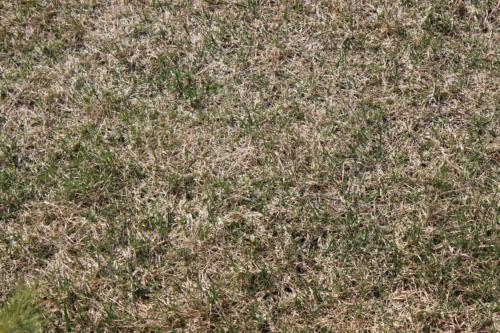Restoring a lawn after winter with ammonium nitrate
First of all, in such a situation, you can advise not to rush. For six months under the snow, the grass dies - this is quite normal. Of course, in Europe, the USA and Canada, where the climate is much milder, the lawn can delight the owners of fresh greenery for a whole year. But if the snow lies for six months, and the ground is frozen by half a meter, do not hope that the spring lawn will be beautiful.
 As practice shows, under a layer of snow, depending on the length of winter and the lowest temperatures, from 45 to 90% of the grass perishes. But this does not mean that the root system is dying. Therefore, it is worth waiting until the snow finally melts, the earth dries up a little and warms up. Most of the roots will almost certainly come to life and sprout. By mid-May - mid-June (depending on the weather and region) the lawn will be almost completely restored. The grass that has died during the winter should be removed - it is best to use a fan rake or a broom for this. But first, wait for the lawn to dry slightly from the melt water. Otherwise, footprints will remain on its surface.
As practice shows, under a layer of snow, depending on the length of winter and the lowest temperatures, from 45 to 90% of the grass perishes. But this does not mean that the root system is dying. Therefore, it is worth waiting until the snow finally melts, the earth dries up a little and warms up. Most of the roots will almost certainly come to life and sprout. By mid-May - mid-June (depending on the weather and region) the lawn will be almost completely restored. The grass that has died during the winter should be removed - it is best to use a fan rake or a broom for this. But first, wait for the lawn to dry slightly from the melt water. Otherwise, footprints will remain on its surface.
Of course, you shouldn't forget about feeding. Knowing how to fertilize your lawn with ammonium nitrate after winter can help your lawn get in top shape faster.
We fertilize the lawn correctly
If you are looking for the right lawn fertilizer, nitrogen mixes are an excellent choice from late spring to mid-summer. After all, it is nitrogen that is first of all needed by the lawn in order to quickly restore the green mass and maintain a great appearance even with regular mowing.
Ammonia can become one of the main suppliers of nitrogen. saltpeter... The nitrogen content in it reaches 35%. Therefore, within 7-10 days after applying the mixture to the soil, you will not recognize your lawn.

The optimal amount of ammonium nitrate is about 30-40 grams per square meter. More specifically, see the instructions on the label. It is advisable to arm yourself with accurate weights so as not to be mistaken with the proportion. You can distribute fertilizer manually, but do it very carefully, and after the end of the procedure, wash your hands thoroughly.
Immediately after spreading the fertilizer, it is advisable to water the lawn well so that the soil gets wet and absorbs the saltpeter faster.
It is advisable to repeat the procedure every month until mid-late August. During this period, phosphate fertilizers should be preferred to strengthen the root system, ensuring that the lawn can easily outlast the winter and do not need to sow seeds in the spring.
However, you need to use nitrate carefully - the acidity of the soil after its introduction increases slightly. On neutral and alkaline soils, this is not dangerous, but on those with high acidity, it can cause plant disease.